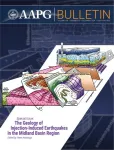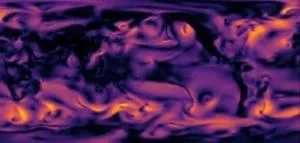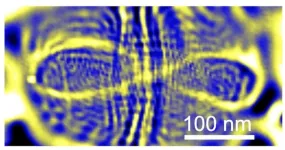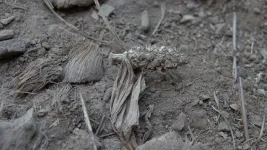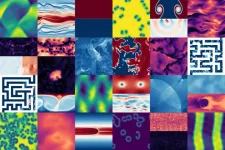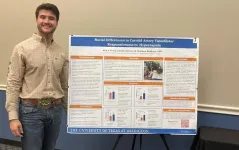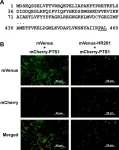(Press-News.org) A new collection of published papers offers the most detailed and comprehensive breakdown yet of how water injected into the Permian Basin during oil and gas operations is changing subsurface pressures and causing earthquakes.
The Permian Basin in West Texas is the country’s most prolific energy-producing region, accounting for more than 40% of the nation’s oil production and about 15% of gas production. However, energy production has caused earthquakes and other challenges in recent years as oil and gas operators now manage roughly 15 million barrels of produced wastewater each day. This briny water comes to the surface as a biproduct of energy production. Most of it is disposed of by being pumped back underground.
The new work, published by scientists at The University of Texas at Austin, is a synthesis of the geology of the Permian Basin, with a particular focus on the Midland Basin, and its interactions with injected water over time. It offers more than a detailed explanation of the issue — it includes information that oil and gas operators and regulators can use in the future to reduce seismicity and associated hazards.
“There have been a lot of recent publications on trends of seismicity in the Permian Basin, but nobody yet has really taken a step back with the consideration, ‘How do you break it down into the geologic and engineering framework that can be used to really understand what’s going on?,’” said Research Professor Peter Hennings, the principal investigator for the Center for Injection and Seismicity Research (CISR). “We’re working to provide a more holistic understanding of the impact of oil field wastewater injection in the Permian Basin region by providing a deep integration of geological data and information to assess the trends and the impact.”
CISR, a research center at the UT Jackson School of Geoscience’s Bureau of Economic Geology, has been investigating the link between seismic activity and injection since 2016. Its science has already helped reduce seismicity in many parts of the Permian Basin.
Hennings is the editor of the new seven-paper study on the Permian Basin, which was published as the December issue of the AAPG Bulletin. The papers build on each other to offer a highly integrated view of the sources and patterns of injection, subsurface reservoirs, faults, pressurization and earthquakes. The geologic maps, pressure models, and data trends published in the papers can help inform operators and regulators about which areas and conditions have been problematic in the past and can assist with mitigation of issues going forward.
Research Associate Professor Katie Smye said the CISR team was able to find many new potentially earthquake-producing faults in the Midland Basin by combining 2D and 3D seismic data with information provided by recent earthquakes and the horizontal wells drilled throughout the area.
“In some cases, they (the wells) track structural changes in the subsurface, and so the tens of thousands of horizontal wells drilled in the past 10 years in this basin are extraordinarily illuminating in our fault mapping efforts,” she said.
The researchers split recent seismicity in the Permian Basin into seven separate induced seismicity systems. Smye said this is important because each system has its own unique geological and seismicity issues. For instance, in some areas the injection is focused deep in geological formations, which is more likely to cause earthquakes than injection into shallow geological formations. However, simply shifting to shallow injection carries other challenges. Increasing pressure in shallow injection zones can make drilling more difficult and potentially damage old wellbores, which can lead to the produced water mixing with groundwater.
Researchers expect production in the Permian Basin to continue at roughly current levels into the foreseeable future, making water disposal a long-term problem. CISR researchers said that understanding how much pore space is available in the Permian region for wastewater disposal is extremely important for sustainable petroleum operations and for safeguarding the environment.
“Pore space for injection has not been traditionally thought of as a resource to be managed effectively. It’s been thought of as something to race to fill,” Smye said. “We need to shift our thinking to the same sort of approach that is taken for sustainable production, so that the pressure space can be maximized for future disposal.”
END
New research provides an improved understanding of earthquake hazards in the Permian Basin
2024-12-02
ELSE PRESS RELEASES FROM THIS DATE:
Physics experiment proves patterns in chaos in peculiar quantum realm
2024-12-02
Where do you see patterns in chaos? It has been proven, in the incredibly tiny quantum realm, by an international team co-led by UC Santa Cruz physicist Jairo Velasco, Jr. In a new paper published on November 27 in Nature, the researchers detail an experiment that confirms a theory first put forth 40 years ago stating that electrons confined in quantum space would move along common paths rather than producing a chaotic jumble of trajectories.
Electrons exhibit both particle and wave-like properties—they ...
Partially domesticated maize is found in caves in Minas Gerais state, Brazil
2024-12-02
Brazilian scientists have determined that ancient specimens of partially domesticated maize (Zea mays, also known as corn) originally from Peruaçu Valley in Minas Gerais state (Brazil) were the farthest from Mexico, the plant’s historic center of origin, of any finds made so far. An article describing their research is published in the journal Science Advances. The study was led by researchers affiliated with the University of São Paulo (USP) and EMBRAPA, the Brazilian Agricultural Research Corporation.
The findings reinforce the theory, based on genetic evidence from plants alive now, that domestication ...
With UH assist, two universities in India launch Doctor of Nursing degree program
2024-12-02
With support from the University of Houston's Andy & Barbara Gessner College of Nursing, two universities in India - MGM Institute of Health Sciences in Mumbai and Krishna Institute of Medical Sciences - have introduced the Doctor of Nursing Practice degree, expanding advanced nursing education in the country. It is the first time any university in India has offered the degree.
The Gessner College graduated its first class of DNP professionals in May 2024.
The DNP doctorate degree ...
New datasets will train AI models to think like scientists
2024-12-02
What can exploding stars teach us about how blood flows through an artery? Or swimming bacteria about how the ocean’s layers mix? A collaboration of researchers from universities, science philanthropies and national laboratories has reached an important milestone toward training artificial intelligence models to find and exploit transferable knowledge between seemingly disparate fields to drive scientific discovery.
This initiative, called Polymathic AI, uses technology similar to that powering large language models such as OpenAI’s ChatGPT ...
Brief scientific literacy interventions may quash new conspiracy theories
2024-12-02
UNIVERSITY PARK, Pa. — The more time you spend on social media, the likelier you are to have come across a viral post that seems too strange to be true. Brief scientific literacy interventions, especially those that focus on critical thinking skills, may help to undermine conspiracy beliefs and behaviors before the conspiracy theories have a chance to take root, according to a team led by Penn State researchers.
The team published their findings in the Journal of Consumer Research.
\“While some conspiracy beliefs may seem relatively harmless, others — about vaccines, genetically modified organisms and climate change, for example ...
Illinois researchers examine teens’ use of generative AI, safety concerns
2024-12-02
CHAMPAIGN, Ill. — Teenagers use generative artificial intelligence for many purposes, including emotional support and social interactions. A study by University of Illinois Urbana-Champaign researchers found that parents have little understanding of GAI, how their children use it and its potential risks, and that GAI platforms offer insufficient protection to ensure children’s safety.
The research paper by information sciences professor Yang Wang, the co-director of the Social Computing Systems Lab, and doctoral student Yaman Yu is one of the first published sources of data on the uses and risks of GAI for children. Wang ...
UTA student recognized for research on high-fat diets
2024-12-02
University of Texas at Arlington senior Ken Perry has always been interested in how the heart works. This curiosity led the Arlington High School graduate to start working in the lab of UTA kinesiology Professor R. Matthew Brothers during his second year of college. Now, two years later, Perry is the recipient of two research awards from the American Physiological Society (APS) for his research on a connection between high-fat meals and cardiovascular health.
“I always wanted to learn about heart and blood flow, so when friend of mine interested in research encouraged me to apply for the SURPINT program ...
Smallest walking robot makes microscale measurements
2024-12-02
ITHACA, N.Y. – Cornell University researchers have created the smallest walking robot yet. Its mission: to be tiny enough to interact with waves of visible light and still move independently, so that it can maneuver to specific locations – in a tissue sample, for instance – to take images and measure forces at the scale of some of the body’s smallest structures.
The team’s paper, “Magnetically Programmed Diffractive Robotics,” published in Science.
“A walking robot that’s small enough to interact with and shape light effectively takes a microscope’s lens and puts it directly ...
Peroxisomal protein boosts plant immunity to thrive under environmental stress
2024-12-02
Salicylic acid is vital for protecting plants from pathogens, but its synthesis remains unclear. A recent study by Shinshu University researchers has discovered that the protein HSR201 is key to its production. They found that HSR201 localizes to specific organelles called peroxisomes through a unique targeting signal. This discovery improves our understanding of how plants produce salicylic acid and could pave the way for developing engineered crops with improved disease resistance.
Plant hormones, or phytohormones, are vital for plant growth, adaptation, and defense. ...
Critical relationship between stem cells and mechanical signals unveiled
2024-12-02
A new study from The Hospital for Sick Children (SickKids) and Institut Curie reveals how stem cells sense and respond to their environment, with implications for inflammatory bowel disease and colorectal cancer.
Stem cells constantly adapt to their environment to maintain organ and tissue health, informed by chemical signals and physical forces. When they do not function as intended, stem cells can result in a number of health conditions including inflammatory bowel disease (IBD) and colorectal (bowel) cancer, where they continue to divide until a tumour forms.
Until ...
